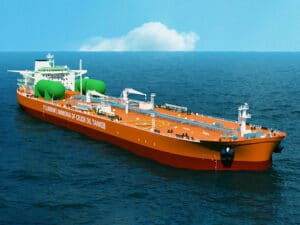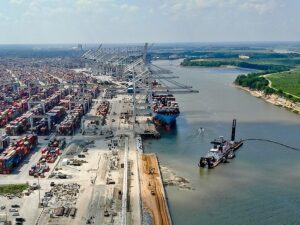
Interlake moves ahead on LNG fuel plans
Written by Nick Blenkey MAY 8, 2013 — Middleburg Heights, Ohio, based Great Lakes operator The Interlake Steamship Company has reached an agreement in principle with Shell to supply liquefied natural gas (LNG) to support Interlake’s conversion of its vessels to LNG as the main propulsion fuel.
MAY 8, 2013 — Middleburg Heights, Ohio, based Great Lakes operator The Interlake Steamship Company has reached an agreement in principle with Shell to supply liquefied natural gas (LNG) to support Interlake’s conversion of its vessels to LNG as the main propulsion fuel.
Originally built in 1952, Kaye E. Baker was converted from steam to diesel last year
When Shell announced, back in March, that it would invest in liquefaction plants to serve marine and heavy duty on-road customers, it said that it expected Interlake to be the first marine customer in the Great Lakes region.
When converted, the Interlake ships are expected to be the first LNG-powered ships on the Great Lakes and among the first in the U.S. With a goal of converting the first vessel by the spring of 2015, Interlake is already working through engineering and design, seeking regulatory approval and securing financing. Shell would be Interlake’s exclusive supplier of LNG for each converted vessel.
Interlake operates a fleet of 10 vessels. Their age profile is a testimony to just how long hulls can remain viable in fresh water Great Lakes service. The youngest is the tug Dorothy Anne, delivered in 1999, which is paired with the 606 ft self-unloading barge Pathfinder entered service in 1998 after conversion from the former straight-deck bulk carrier, Steamer J. L. Mauthe, which was built in 1953 for the Interlake Steamship Company. The flagship of the fleet, and at 1,013.5 ft the longest laker in service, was built in 1981.
The oldest ship in the fleet is the M/V Lee A. Tregurtha, which is the most converted vessels in the Great Lakes fleet and probably the only ship still in service with two battle stars for World War II service, the original ship underneath all the conversions being the WWII tanker Mobiloil. Still, making the point that investments in lakers can make sense regardless of their original delivery date, she was converted from steam to diesel propulsion as recently as 2006.
Interlake says that the conversion of its vessels from heavy fuel oil burning engines to engines that operate on LNG will require significant capital investments, but those investments are expected to result in significant environmental benefits. Interlake anticipates that the conversion to LNG will result in significant reductions of carbon dioxide, sulfur oxide, nitrogen oxide and particulate matter.
“This move takes our dedication to environmental stewardship to the next level,” explains Mark Barker, President of Interlake. “While the marine mode of transportation is already by far the most environmentally friendly way to move goods throughout the Great Lakes region, operating on LNG would further reduce our vessels’ environmental impacts. We not only respect the needs of our customers, but work to minimize the impact on the waterways which we operate.”
The move to LNG allows Interlake to use a fuel that is sourced, produced and distributed entirely in North America, reducing the use of and reliance on imported fossil fuels.
“The marine transportation industry already supports thousands of jobs and billions of dollars in wages throughout the Great Lakes,” adds Barker. “We are now evolving in a way that would allow Interlake to participate in the long-term growth and economic prosperity of the region that it has served for 100 years. This move allows us to back the growing natural gas industry, which is also creating valuable jobs here in the U.S.”
Shell announced plans last month to invest in a liquefaction unit at its Sarnia Manufacturing Centre in Ontario, Canada. Once operational, this project will supply LNG fuel throughout the Great Lakes, their bordering U.S. States, Canadian provinces and the St. Lawrence Seaway.





Leave a Reply
You must be logged in to post a comment.